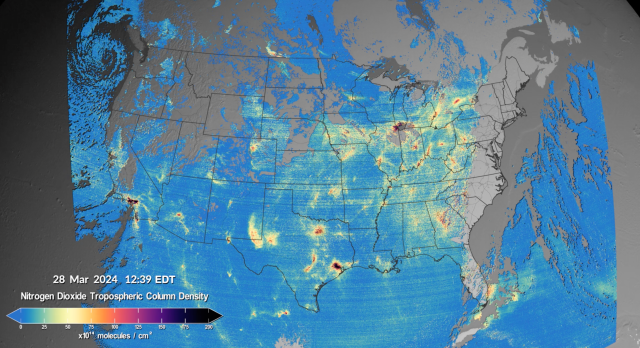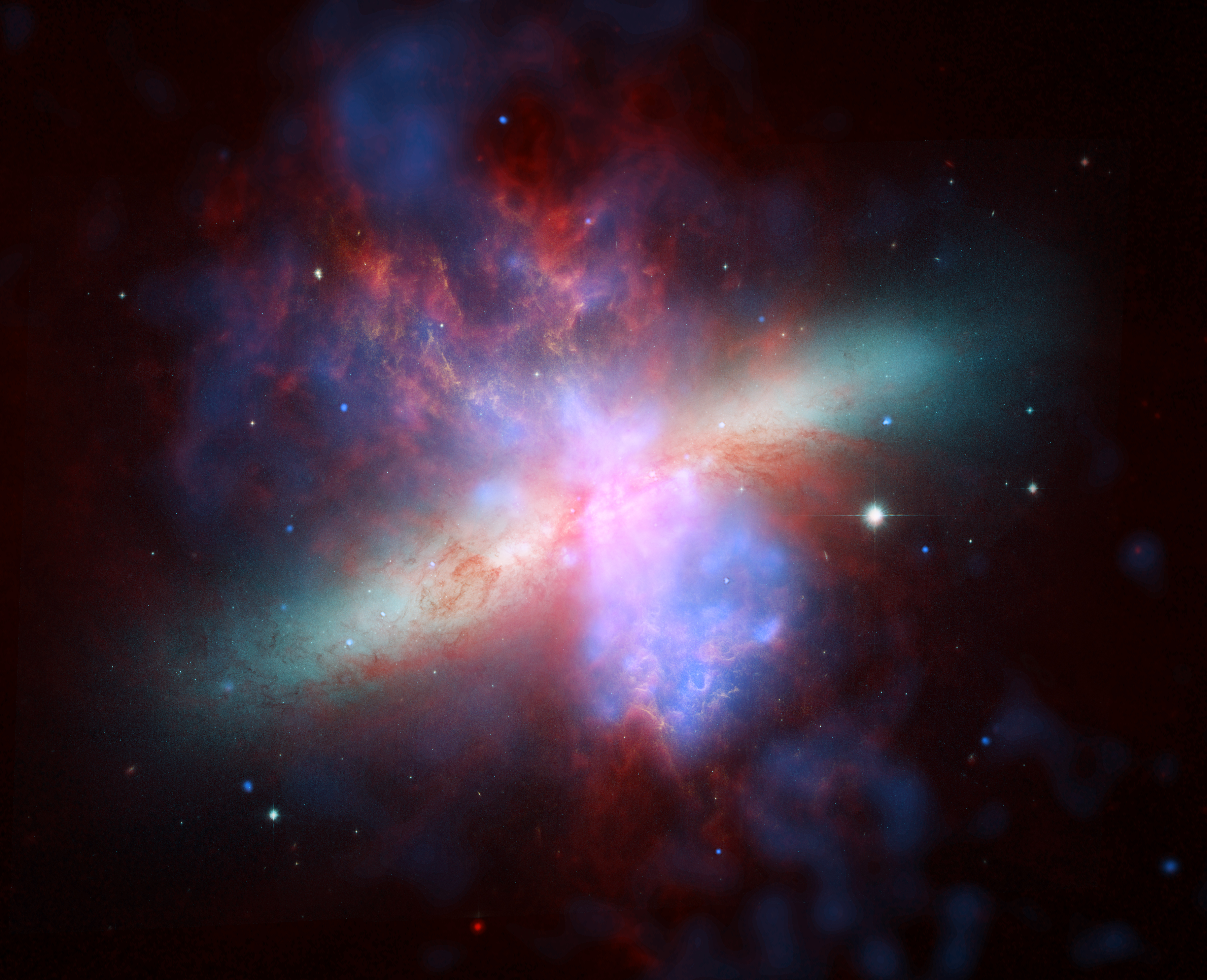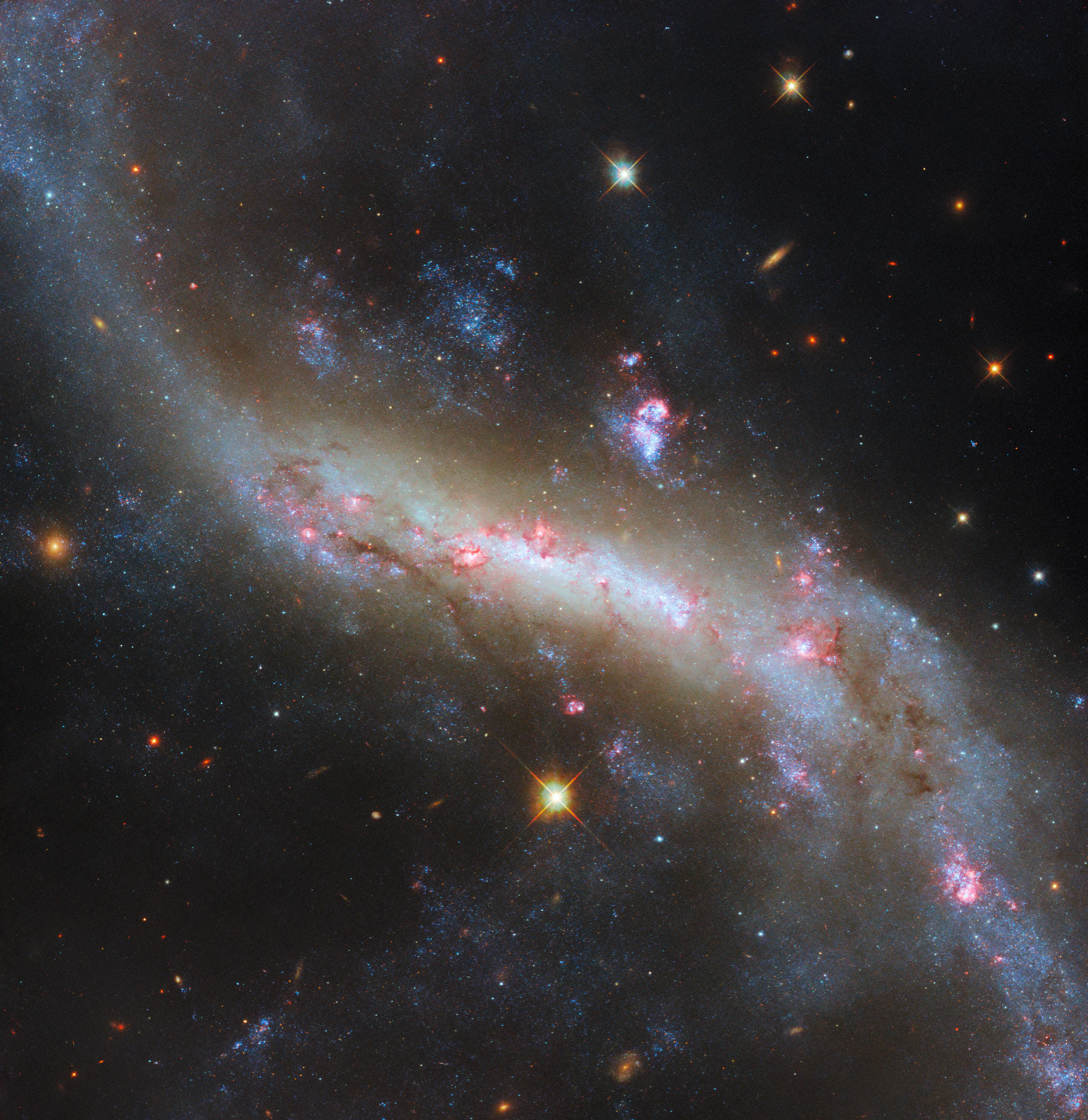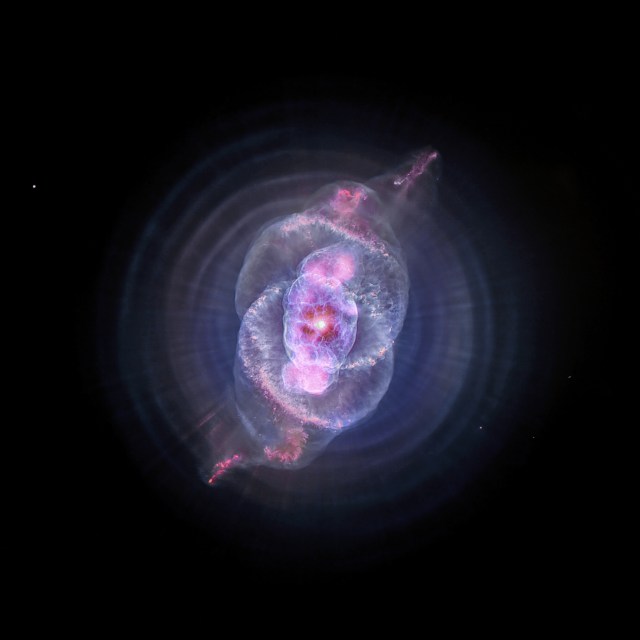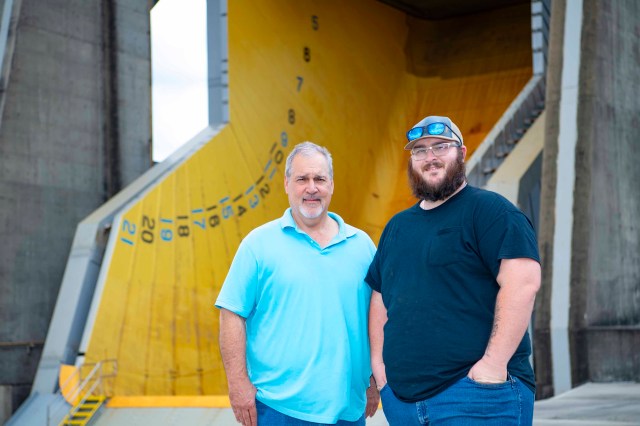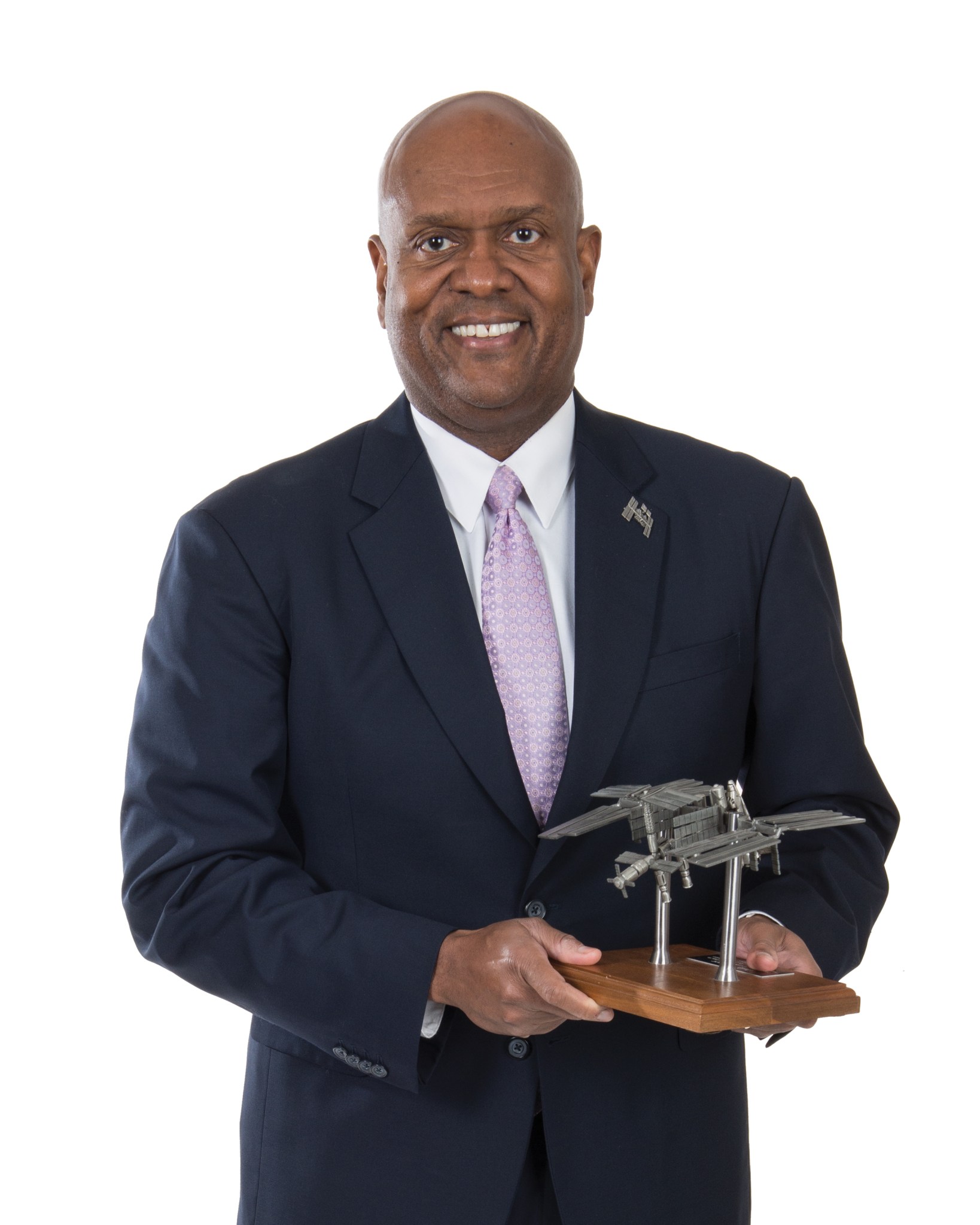In This Week’s Star
- Marshall Advances 3-D Printed Rocket Engine Nozzle Technology
- Marshall’s Bobby Watkins Strives for Mission Success, Will Share Thoughts on How to Achieve it March 22
- NASA Acting Administrator Robert Lightfoot at National Space Club Huntsville Breakfast: NASA ‘A Demonstration of What This Nation Can Do’
- Marshall, U.S. Army Facilities Emergency-Response Teams Go to ‘Heroic’ Lengths to Keep Redstone Arsenal Warm, Dry and Operational
- 45 Teams, More Than 1,500 Students Compete at FIRST Robotics Rocket City Regional
- Marshall’s Keith Parrish, U.S. Space & Rocket Center’s Deborah Barnhart Honored at Goddard Memorial Symposium
- This Week in NASA History: ATLAS-1 Launches – March 24, 1992
- Obituaries
Marshall Advances 3-D Printed Rocket Engine Nozzle Technology
By Jonathan Deal
Rocket engine nozzles operate in extreme temperatures and pressures from the combustion process and are complex and expensive to manufacture. That is why a team of engineers at NASA’s Marshall Space Flight Center developed and proved out a new additive manufacturing technique for nozzle fabrication that can greatly reduce costs and development time.
A new process called Laser Wire Direct Closeout (LWDC) was developed and advanced at NASA to build a less-expensive nozzle in significantly less time. LWDC is a different process than most 3-D printing technologies, which are powder-based and fabricated in layers. It uses a freeform-directed energy wire deposition process to fabricate material in place. This new NASA-patented technology has the potential to reduce build time from several months to several weeks.
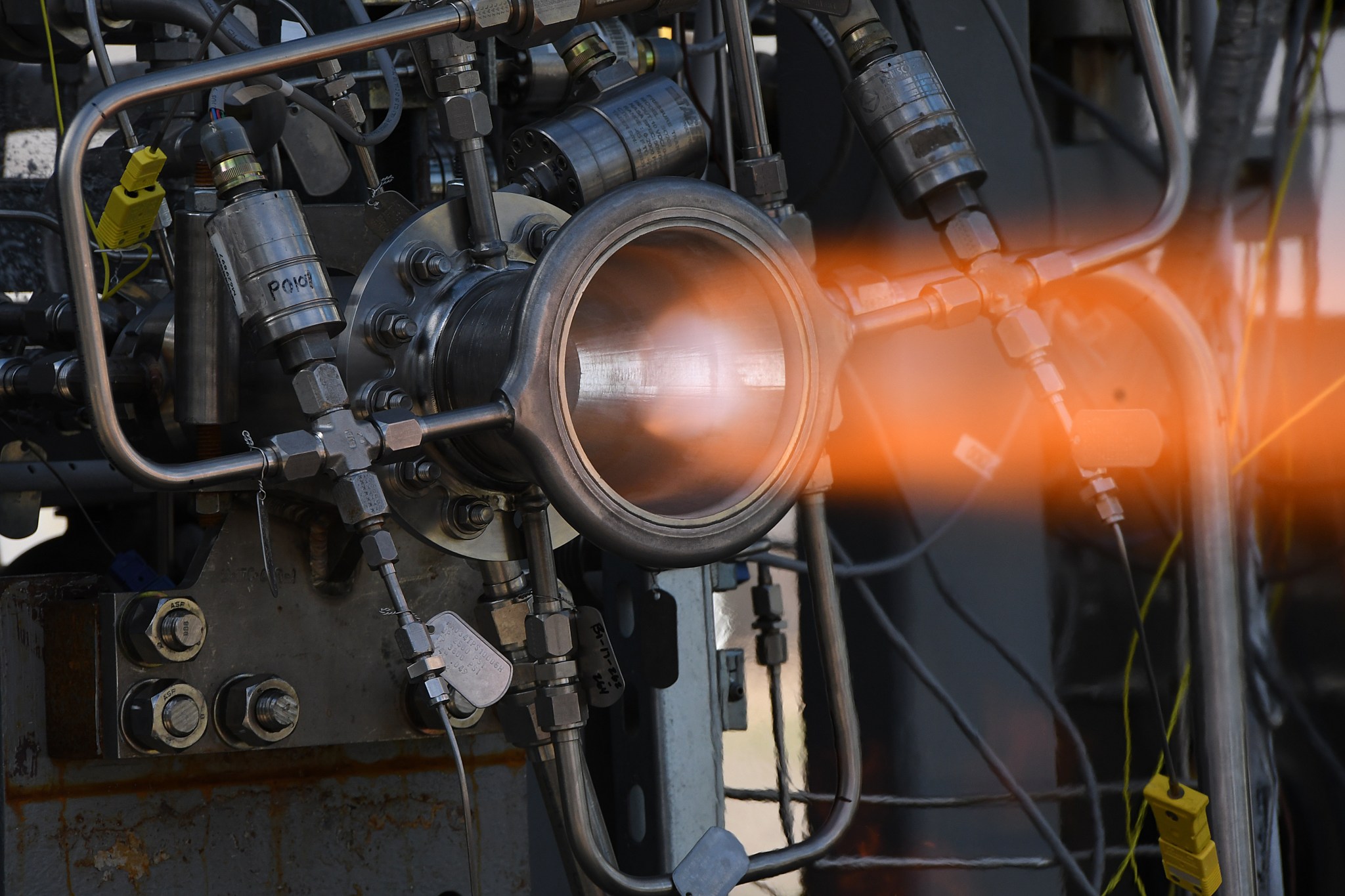
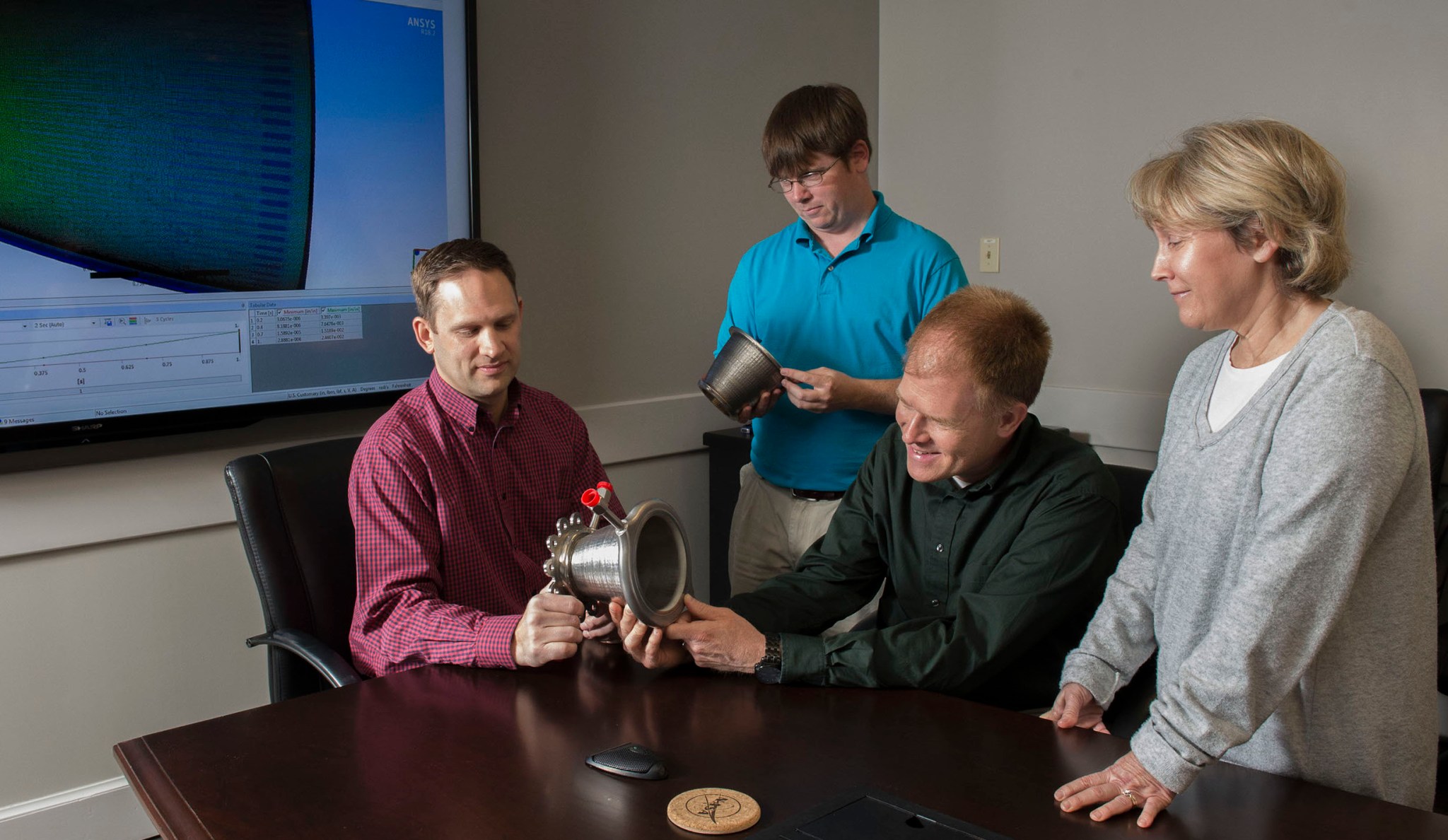
“NASA is committed to revitalizing and transforming its already highly advanced manufacturing technologies for rocket engines,” said Preston Jones, director of the Engineering Directorate at Marshall. “What makes this development project even more unique is there were three separate, state-of-the-art, advanced manufacturing technologies used together to build a better nozzle and prove it out through hot-fire testing — an example of why Marshall continues to be a worldwide leader in manufacturing of propulsion technologies.”
Nozzles may look simple from the outside, but they are very complex. The new LWDC method employs a wire-based additive manufacturing process to precisely close out the nozzle coolant channels, which contain the high-pressure coolant fluid that protects the walls from the high temperatures a nozzle must withstand. Nozzles are actively cooled, or regeneratively cooled, meaning the propellant later used in the combustion cycle is routed through the nozzle to properly cool the walls so they do not overheat. To regeneratively cool the nozzles, a series of channels are fabricated within the nozzle, but then must be closed out, or sealed, to contain the high-pressure coolant. The new patented process using the LWDC technology closes out the coolant channels and forms a support jacket in place, reacting structural loads during engine operation.
“Our motivation behind this technology was to develop a robust process that eliminates several steps in the traditional manufacturing process,” said Paul Gradl, a senior propulsion engineer in Marshall’s Engine Components Development & Technology Branch. Gradl has focused his whole career on rocket nozzles and combustion chambers, like this one developed and patented at Marshall. “The manufacturing process is further complicated by the fact that the hot wall of the nozzle is only the thickness of a few sheets of paper and must withstand high temperatures and strains during operation.”
After Marshall co-developed and patented the LWDC process, Keystone Synergistic of Port St. Lucie, Florida, used the technology to fabricate and test a nozzle. Through hot-fire testing at Marshall, engineers put this nozzle through its paces, accumulating more than 1,040 seconds at high combustion chamber pressures and temperatures. Now, this technology is being licensed and considered in commercial applications across the industry.
The second technology tested as part of this campaign was an abrasive water jet milling process to form the coolant channels advanced by Ormond, LLC of Auburn, Washington, while a further technology developed was an arc-based deposition technology to additively manufacture the near net shape liner that would contain the water jet milled channels. All three technologies were developed through NASA’s Small Business Innovation Research program, working to bring together the agency with its industry partners to advance manufacturing. With projects such as these, Marshall is stimulating small business to maximize the return on America’s investment in space technology and exploration.
“One of the things I get excited about is advancing and proving out new technologies for our application with industry partners that a private space company can then use as part of its supply chain,” said Gradl. “That was the objective behind some of this — we formulated the concept, worked with external vendors, and now we’re partnering to infuse this new technology throughout industry to improve advanced manufacturing.”
Deal, an ASRC Federal/Analytical Services employee and Marshall Star Editor, supports the Office of Strategic Analysis & Communications.
Marshall’s Bobby Watkins Strives for Mission Success, Will Share Thoughts on How to Achieve it March 22
By Rick Smith
Whether Bobby Watkins, director of the Human Exploration Development and Operations Office at NASA’s Marshall Space Flight Center, is inspiring his team, the public or new generations of scientists and engineers, he always points out NASA’s dynamic, team-oriented culture. NASA’s legacy of ingenuity, shared ideas and commitment to succeed, he says, are crucial to its decades of achievement as well as its future exploration and discovery.
Watkins will discuss these aspects of mission success and more in his presentation for the “Mission Success is in Our Hands” lecture series March 22 at 11:30 a.m. in Building 4200, Room P110. The series is sponsored by Marshall’s Safety & Mission Assurance Directorate and Jacobs Engineering to help promote and strengthen Marshall’s focus on mission, hardware and crew safety.
Watkins brings inclusive, team-affirming tactics to his office, which was formed in 2017 with Watkins as its first director. The office, also known as HEDO, oversees Marshall’s human exploration-themed space operations in and beyond low-Earth orbit — including commercial space transportation — which complement NASA’s new flagship rocket, the Space Launch System and supports increased science aboard the International Space Station.
His team oversaw the first-ever White House-level call to the space station crew from Marshall during Vice President Mike Pence’s visit to the center in September 2017, and it’s been laying the groundwork for increased science capabilities on station since last June, when the team’s members helped prepare ground-operations personnel for the long-awaited expansion of the station’s permanent American crew from three members to four. In the wake of that increase, the Payload Operations Integration Center team at Marshall recently was recognized for supporting more than 100 hours of crew utilization aboard the station in a single week.
Watkins credits his team members’ “passion, talent and dedication” for all these wins. “They streamlined the workflow, operations and communications processes to increase efficiency while still working their day jobs,” he said. “We’re excited about expanding our capacity for science in orbit.”
He’s equally excited about continuing to build a world-class team to achieve NASA’s human exploration missions — and that means championing diversity and inclusion.
“I’m committed to achieving continued mission success in Marshall’s HEDO organization, pursuing new talent and new ideas wherever we may find it,” Watkins continued. “The space program has always sought to attract and retain the best and brightest. Our efforts to build the most diverse, creative and energetic team possible are partly why NASA has been named the best place to work in the federal government for the past six years.”
During his 32-year NASA career, Watkins served as director of NASA’s Michoud Assembly Facility; director of Marshall’s Office of Strategic Analysis and Communications; chief of staff at NASA’s Johnson Space Center; and director of the Legislative Liaison Division in NASA’s Office of Legislative and Intergovernmental Affairs. He is a member of the American Astronautical Association, National Society of Black Engineers, the National Technical Association and the Marshall Association.
More information about Watkins’ March 22 presentation is available here.
Smith, an ASRC Federal/Analytical Services employee, supports the Office of Strategic Analysis & Communications.
NASA Acting Administrator Robert Lightfoot at National Space Club Huntsville Breakfast: NASA ‘A Demonstration of What This Nation Can Do’
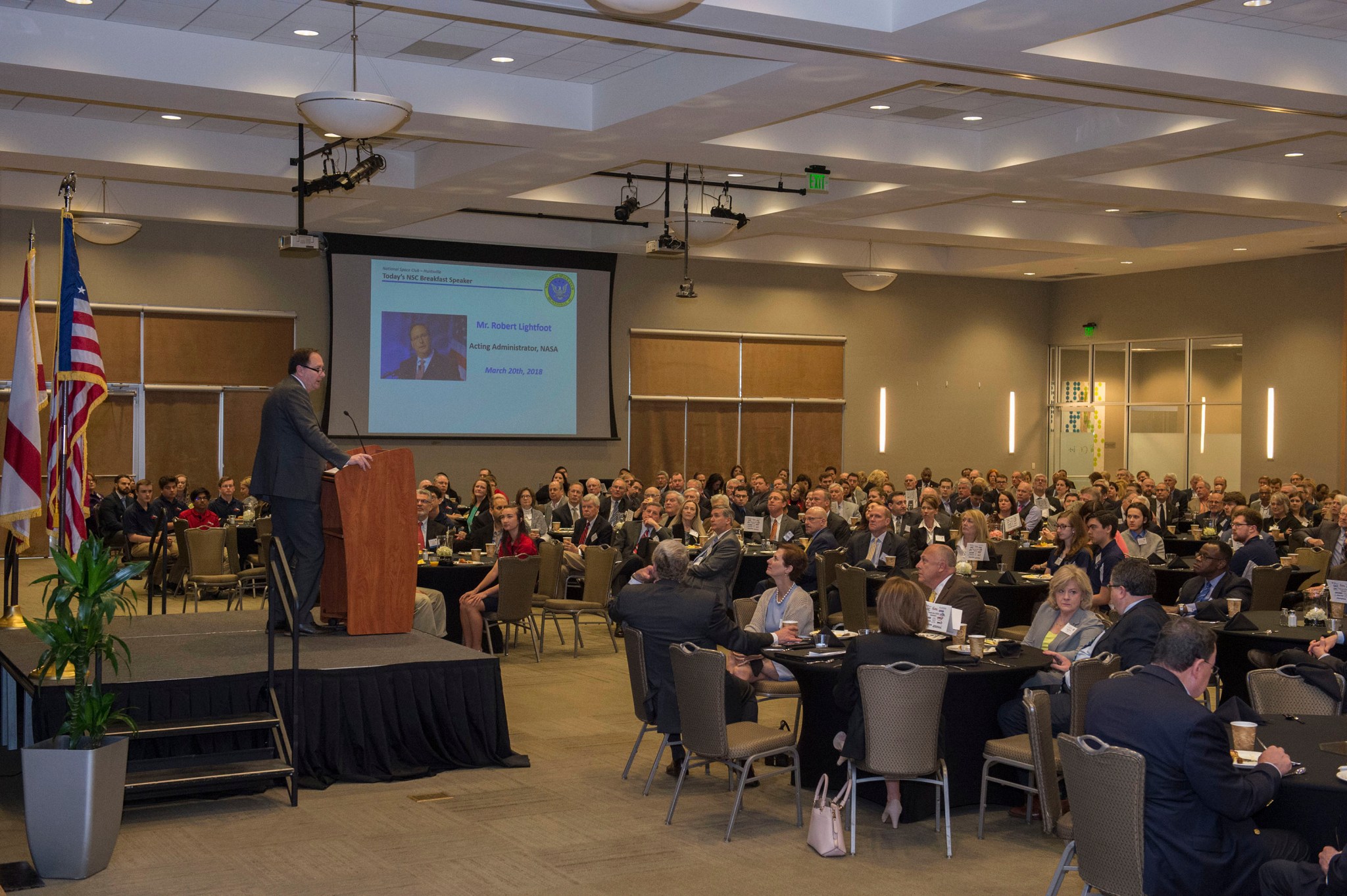
NASA Acting Administrator Robert Lightfoot addresses a standing room-only crowd at the March 20 National Space Club Huntsville breakfast. Lightfoot, who recently announced he will be retiring from the agency on April 30, praised NASA’s Marshall Space Flight Center and spoke about where the agency is headed over the next two decades. “I get to be nostalgic now, as I leave the Agency. This work was going on before I got here, and it’s going to keep going on after I leave,” said Lightfoot. “In this nation where we hear a lot about what we can’t do, NASA is a demonstration of what this nation can do. The Space Launch System rocket is taking shape right here at Marshall. The passion our team has on our exploration journey is second to none and there seems to be a sense of urgency to get to that first launch. Exploration gives us hope for the future, and brings today’s generation on board to forge its own path to the next great milestones for humanity.” National Space Club Huntsville’s mission is to promote the awareness of civilian and military applications for rocketry and astronautics. Participation in its events helps raise money for scholarships and STEM engagement in the community. To learn more about the club, click here. (NASA/MSFC/Emmett Given)
Marshall, U.S. Army Facilities Emergency-Response Teams Go to ‘Heroic’ Lengths to Keep Redstone Arsenal Warm, Dry and Operational
By Rick Smith
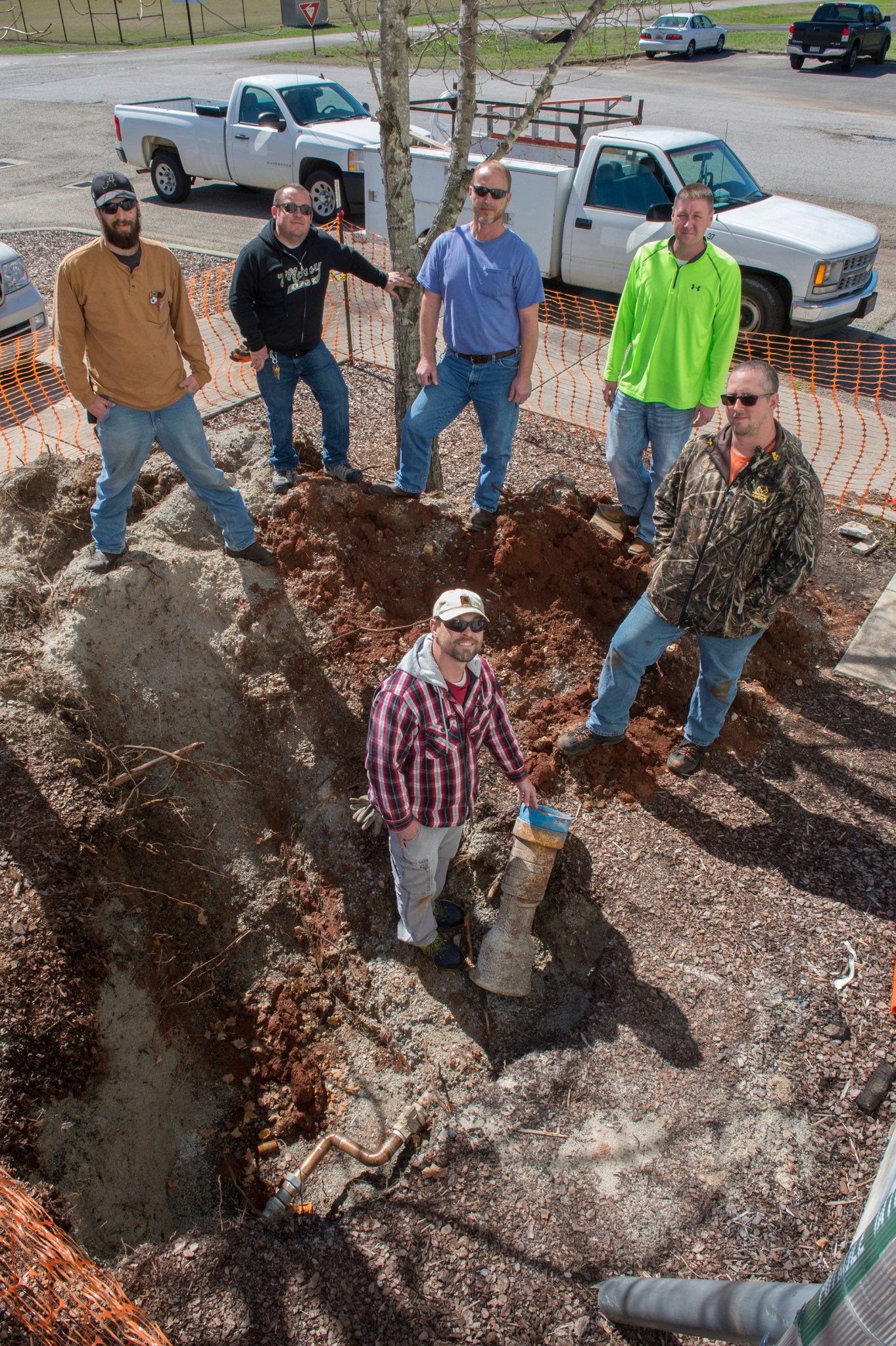
As winter begins to relinquish its grip on North Alabama and overnight temperatures dip from bitter to merely bracing, NASA’s Marshall Space Flight Center and U.S. Army organizations across Redstone Arsenal can thank the on-site facilities teams who brave the elements at all hours for maintaining the electricity, heat and running water thousands here rely on daily.
Members of Marshall’s Facilities Operations and Maintenance Office and the Base Operations Division of Redstone Arsenal’s Directorate of Public Works jointly support overnight emergency-response actions — repairing everything from burst water pipes to electrical outages — to keep personnel dry, warm and working.
Marshall’s Utility Control System — the automated service which tracks facilities issues and incidents and triggers an official response to emergency power, plumbing and other utility issues across the arsenal — is a “24/7 operation,” according to Kevin Primm, chief of the Facilities Operations and Maintenance Office, a branch of Marshall’s Facilities Management Office.
“Facilities issues are reported to Utility Control — often at night, by someone working late or by security personnel walking through a building — and they call the appropriate NASA or Army facilities personnel to respond,” said Roy Malone, director of Marshall’s Office of Center Operations, which oversees hundreds of engineers and utility specialists in the Facilities Management Office.
“Approximately 10 or 12 workers take part on our rotating overnight teams. They do admirable, even heroic work to keep our systems online,” Malone said.
Keith Cook, chief of the Base Operations Division of the Redstone Garrison’s Directorate of Public Works, confirmed the same on the Army side of the arsenal. “We maintain a 24-hour, control room desk, seven days a week, with five dedicated personnel on the desk ready to call in specialists as needed,” he said.
These teams, like all organizations across the federal installation, rely on key contractor support. URS Federal Services Inc. of Germantown, Maryland, provides facilities operations and maintenance support services for Marshall. Wolf Creek Federal Services of Anchorage, Alaska, handles those duties for Redstone’s military tenants.
Because many facilities across the arsenal date back to the 1960s, breaks in utility lines and pipes in those buildings aren’t unexpected. “Ten or 15 years ago, the issue was most often electricity,” Primm said. “Now it’s water.”
When temperatures plunge at night during icy spells, those old pipes can sometimes freeze and burst. That happened twice this January, with one incident resulting in a potable-water outage Jan. 4 in Buildings 4476 and 4487, potentially impacting more than 500 workers at those sites.
“Most people are asleep at those hours, and miss seeing the response — a group of people in a hole, knee-deep in mud and water, in the middle of the night, with temperatures down to 10 or 20 degrees,” Malone said.
Redstone and Marshall stay prepared for such eventualities. Facilities engineers and team leads maintain emergency action plans to handle just about any anticipated crisis, from late-night outages tied to freezing weather to unexpected superstorms. “We maintain a call list, and work closely with Redstone’s work control center, keeping them updated if we’re not jointly responding to a call,” Primm said.
The teams stay alert to approaching winter conditions to determine the need for on-site work crews. Overnight emergency responders function much like firefighters, Malone said. “We pretreat roads, keep people on standby,” he said. “If they aren’t responding to calls, they stay in their duty stations, mostly in Building 4650. We have cots, so they can catch some sleep between calls.”
Even in the event of unforeseen arsenal closures such as a government shutdown, he added, “Center Ops never stops. We keep a team of emergency personnel on site. They become our eyes and ears when no one else is here.”
Malone, Primm and Cook praised the teams that resolve crises most arsenal workers will never even be aware of. “It’s a particularly thankless job most of the time,” Malone said. “When it’s working, no one says anything, but we’re extremely grateful for all they do.”
To submit a facilities work request, Marshall team members may call 256-544-HELP, then press 4 when prompted by the automated system. Should motorists or late-night workers see a water line break or power outage elsewhere on the arsenal, they should telephone the 24-hour call desk at 256-876-2801.
Smith, an ASRC Federal/Analytical Services employee, supports the Office of Strategic Analysis & Communications.
45 Teams, More Than 1,500 Students Compete at FIRST Robotics Rocket City Regional
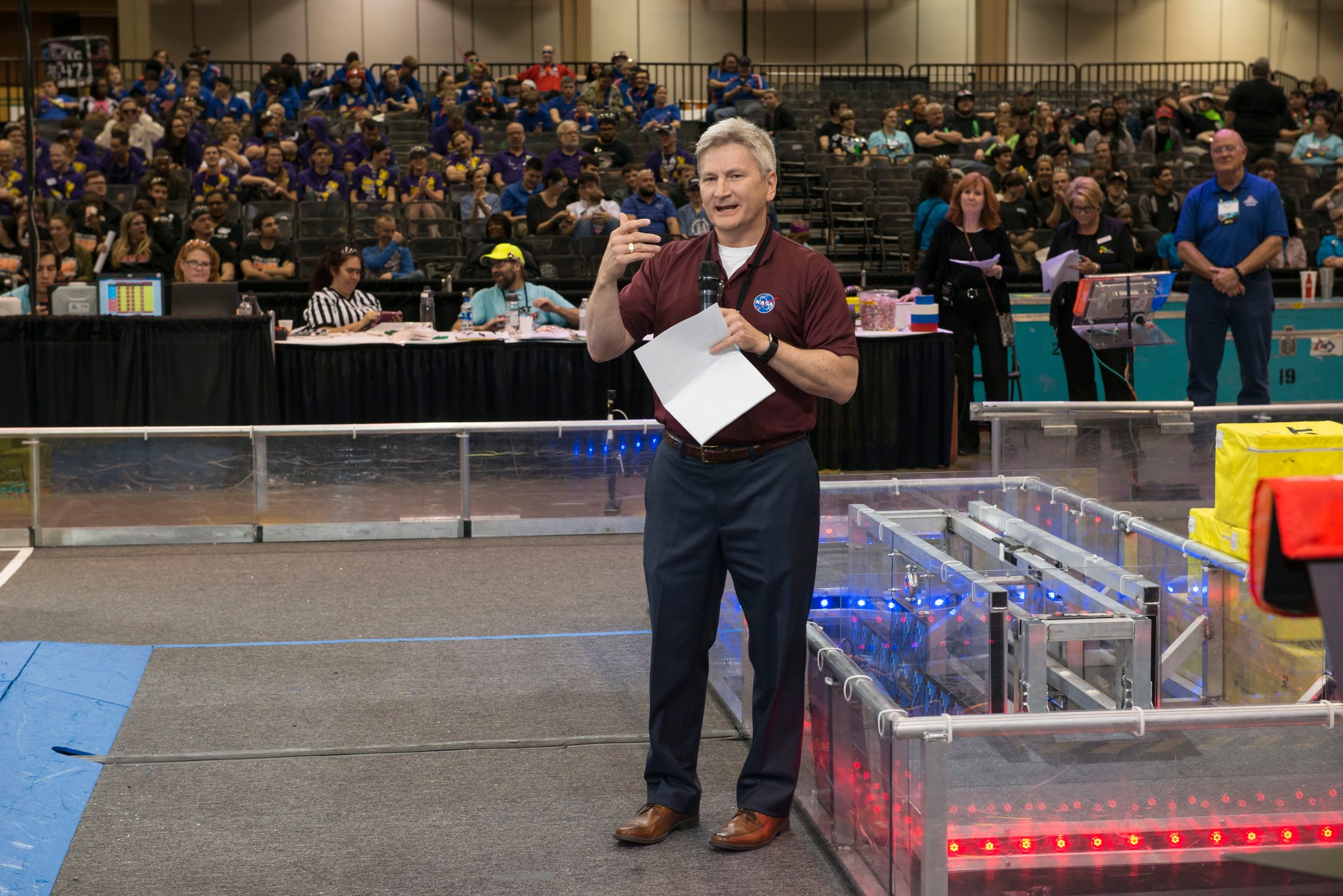
Johnny Stephenson, director of NASA Marshall Space Flight Center’s Office of Strategic Analysis & Communications, addresses the crowd during the March 16 award ceremony following the first day of competition at the FIRST Robotics Rocket City Regional at the Von Braun Center in Huntsville. Ed Sparks, of the Morgan County Mech Tech team, received the award for Volunteer of the Year at the March 16 award ceremony. Mech Tech, comprised of students from five high schools in Morgan County, Alabama, also won the Industrial Design Award. The team was one of three regional finalists that will advance to the FIRST national championships April 18-21 in Houston. The other two regional finalists were Burning Magnetos of Fort Dorchester High School in North Charleston, South Carolina, and OGRE of Opelika High School in Opelika, Alabama. Mech Tech and Golden Hurricane from Columbia High School in Huntsville, were “house” teams sponsored by Marshall. (NASA/MSFC/Fred Deaton)
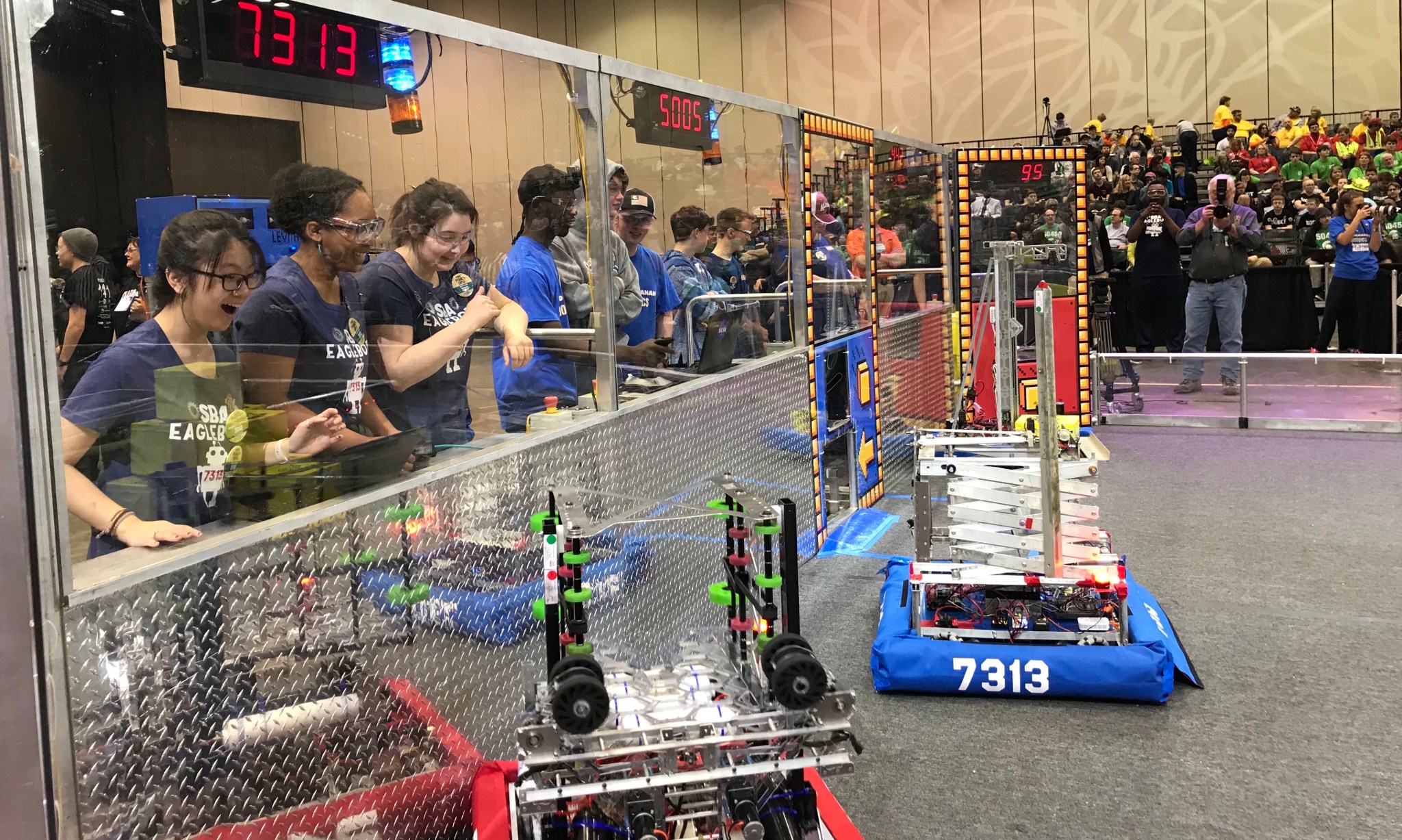
SBA Eaglebots from Cordova, Tennessee, at left in navy, focus on maneuvering their robot March 16 at the FIRST Robotics Rocket City Regional. More than 1,500 students on 45 teams from 11 states and Brazil competed against one another during the two-day event in a new robotics game called, “FIRST POWER UP,” in which students complete tasks by controlling their respective robots. FIRST — “For Inspiration and Recognition of Science and Technology” — Robotics Competition is a worldwide program for students in grades 9-12 that inspires the next generation of explorers to pursue careers in the “STEM” fields of science, technology, engineering and math. (NASA/MSFC/Jonathan Deal)
Marshall’s Keith Parrish, U.S. Space & Rocket Center’s Deborah Barnhart Honored at Goddard Memorial Symposium
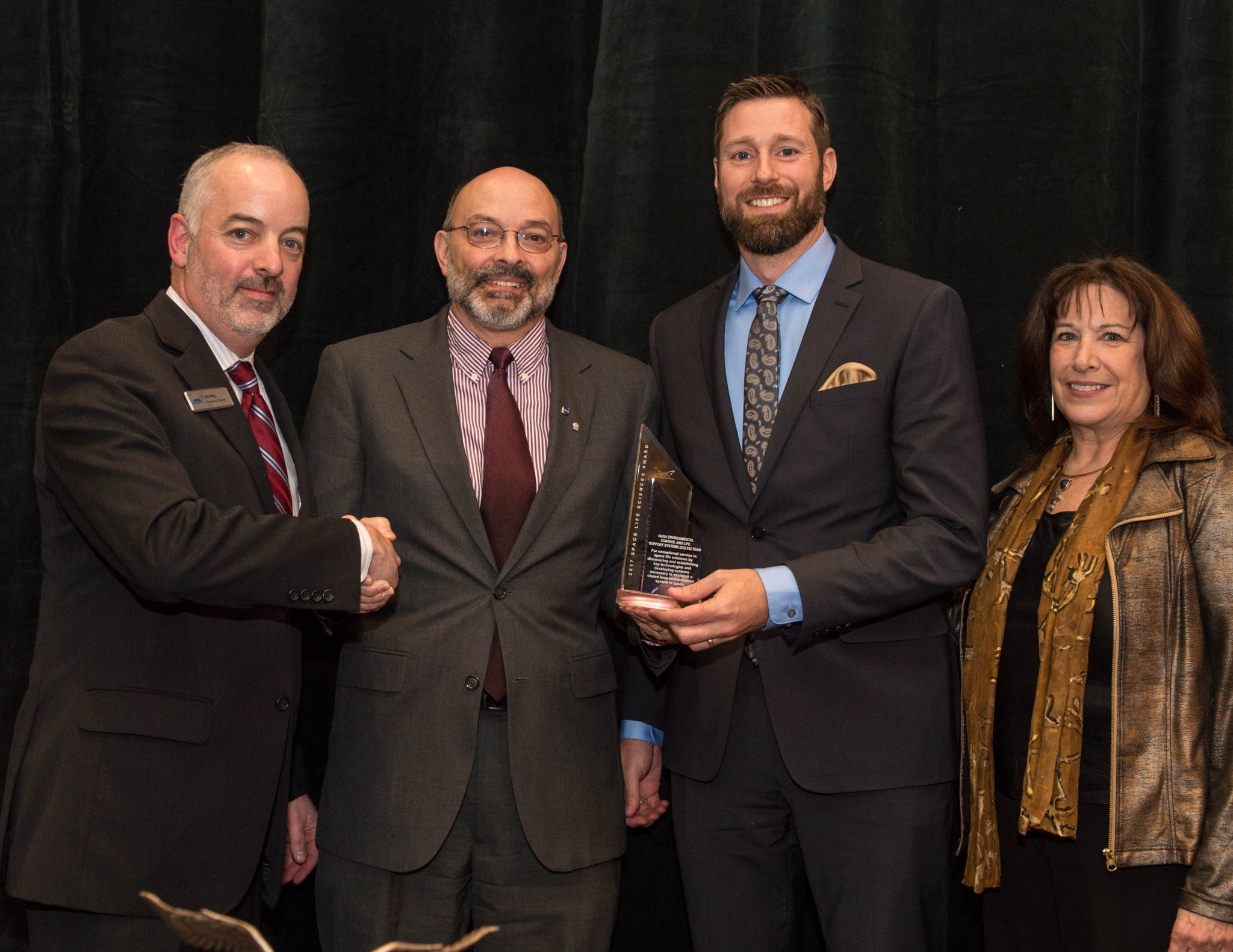
The American Astronautical Society presented its 2017 Space Life Sciences Award to the Environmental Control and Life Support Systems team at NASA’s Marshall Space Flight Center March 14 during the Goddard Memorial Symposium in Greenbelt, Maryland. Marshall ECLSS team lead Keith Parrish, second from left, accepted the award from AAS Director Jim Way, left, and AAS President Carol Lane, right. Also receiving the 2017 Space Life Sciences Award was Jonathan Bowie, second from right, assistant branch manager for the life support branch of NASA Johnson Space Center’s Crew and Thermal Systems Division. The award honors exceptional service in discovering and establishing key technologies and developing systems necessary to establish a closed-loop environmental system in space. (NASA/Bill Hrybyk)
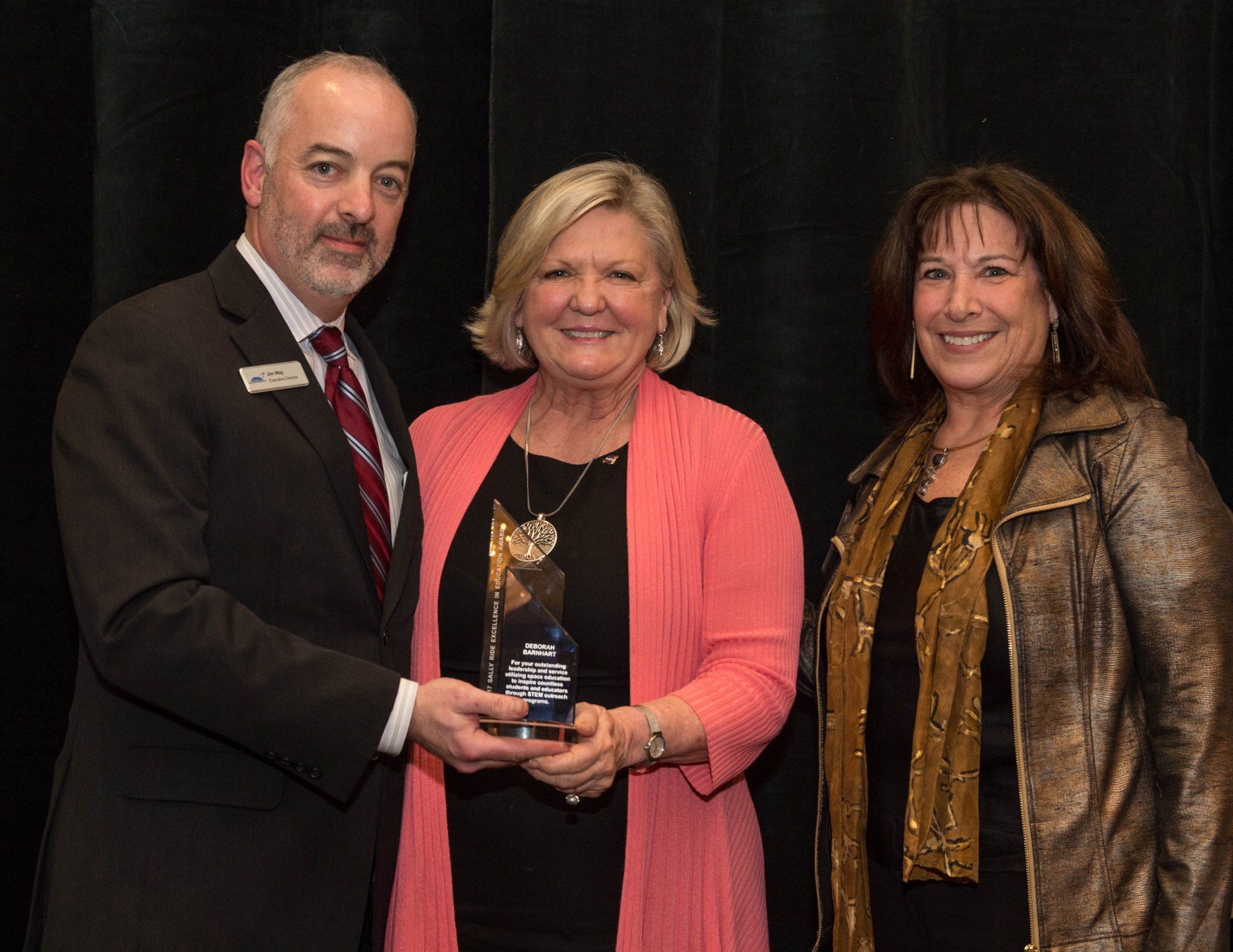
U.S. Space & Rocket Center Executive Director Deborah Barnhart, center, received the American Astronautical Society’s 2017 Sally Ride Excellence in Education Award from AAS Director Jim Way, left, and AAS President Carol Lane at the March 14 Goddard Memorial Symposium. Barnhart was recognized for outstanding leadership and service utilizing space education to inspire countless students and educators through STEM outreach programs. The rocket center is the official visitor center for Marshall. (NASA/Bill Hrybyk)
This Week in NASA History: ATLAS-1 Launches – March 24, 1992
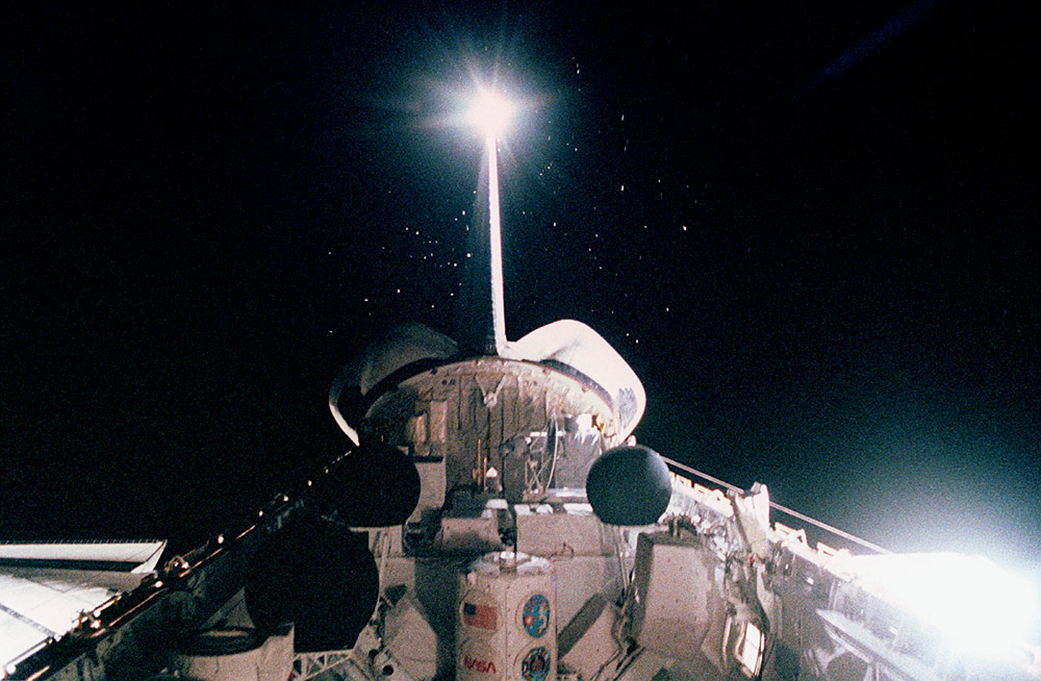
This week in 1992, the space shuttle Atlantis, mission STS-45, launched from NASA’s Kennedy Space Center. The mission carried the first Atmospheric Laboratory for Applications and Science, ATLAS-1, on Spacelab pallets mounted in the orbiter’s cargo bay. The non-deployable payload was equipped with 12 instruments from the United States, France, Germany, Belgium, Switzerland, the Netherlands and Japan, and conducted studies in atmospheric chemistry, solar radiation, space plasma physics and ultraviolet astronomy. Here, the forward portion of ATLAS-1 is visible in the open cargo bay of the orbiter. The ATLAS mission was part of the series of Spacelab missions managed by NASA’s Marshall Space Flight Center. The NASA History Program is responsible for generating, disseminating and preserving NASA’s remarkable history and providing a comprehensive understanding of the institutional, cultural, social, political, economic, technological and scientific aspects of NASA’s activities in aeronautics and space. For more pictures like this one and to connect to NASA’s history, visit the Marshall History Program’s webpage. (NASA)
Obituaries
Charles F. Smith, 88, of Huntsville, died Thursday, March 15. He retired from the Marshall Center in 1985 as a materials analyst. He is survived by his wife, Lillian M. Smith.


